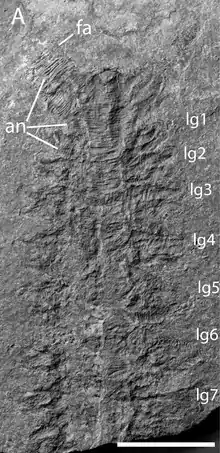Pambdelurion
Pambdelurion is an extinct genus of panarthropod from the Cambrian aged Sirius Passet site in northern Greenland. Like the morphologically similar Kerygmachela from the same locality, Pambdelurion is thought to be closely related to arthropods, combining characteristics of "lobopodians" with those of primitive arthropods.
| Pambdelurion Temporal range: | |
|---|---|
 | |
| Fossil specimen | |
| Scientific classification | |
| Domain: | Eukaryota |
| Kingdom: | Animalia |
| Phylum: | Arthropoda |
| Class: | †Dinocaridida |
| Genus: | †Pambdelurion Budd, 1997 |
| Species: | †P. whittingtoni |
| Binomial name | |
| †Pambdelurion whittingtoni Budd, 1997 | |
Description

Pambdelurion was large for a Cambrian animal, and is estimated to have reached a length of 55 centimetres (22 in).[1] Omnidens, an organism from China that closely resembles Pambdelurion and may even be synonymous with it, reached even larger sizes, estimated to be 1.5 metres (4.9 ft) based on the proportions of Pambdelurion.
The head of Pambdelurion bore a large pair of frontal appendages, homologous to the antennae of onychophorans and frontal appendages of radiodonts. These frontal appendages were weakly muscled and relatively soft, suggesting they may have served primarily as sensory organs, rather than for grasping prey.[2] Between the appendages are a pair of clusters of three spines, which probably served a sensory function.[3] Eyes have not been identified. On the ventral surface of the head was the mouth, which was an oral cone similar to that of other non-arthropod ecdysozoans.
The body possessed eleven pairs of non-muscular, gill-bearing lateral flaps and eleven pairs of lobopodous legs ventral to the flaps. The body musculature was more similar to that of onychophorans than that of arthropods. The cuticle was unsclerotized.
The anterior portion of the gut was a large, muscular pharynx, as in many other ecdysozoans. More posteriorly, the gut contained paired glands.
History of study
Pambdelurion whittingtoni was named in 1997 by Graham E. Budd. The genus name comes from Greek pambdelyrion "all-loathsome" in reference to the fearsome appearance of the animal, and the specific name honors the paleontologist Harry B. Whittington.[4]
The holotype is MGUH 24508.
Classification
| |||||||||||||||||||||||||||||||||||||||||||||
| Phylogeny of stem-group arthropods, with disputed relationships represented as polytomies[5][6][7] |
Pambdelurion is regarded as a member of Lobopodia, a paraphyletic group of panarthropods that includes the ancestors of modern tardigrades, onychophorans, and arthropods. It is more closely related to arthropods than to any other modern group, but it diverged from the arthropod lineage before the last common ancestor of all modern arthropods; as such, is a stem-group arthropod. Pambdelurion is part of a group of stem-arthropods known as the gilled lobopodians, which consists of lobopodians with gill-bearing lateral flaps and also includes Kerygmachela and Opabinia.[8] The gilled lobopodians are the closest relatives of the arthropods among lobopodians, and both the radiodonts and true arthropods are descended from a gilled lobopodian ancestor.
Omnidens, from the near-contemporaneous Maotianshan Shales of China, cannot be clearly distinguished from Pambdelurion, and it is possible that they are synonymous.[1] However, there is no evidence of gilled lobopodians like Pambdelurion in the Maotianshan Shales, so Omnidens may be the mouthparts of some other lobopodian, such as Megadictyon or Jianshanopodia.
Paleobiology
Pambdelurion was probably a predator, with a diet including arthropods.[9]
Pambdelurion was probably a benthic animal that lacked the ability to swim effectively.[2]
Paleoecology
Pambdelurion was one of the largest and most abundant organisms in the Sirius Passet biota.
References
Works cited
- Budd, G. E. (1997). "Stem group arthropods from the Lower Cambrian Sirius Passet fauna of North Greenland". In Fortey, R. A.; Thomas, R. H. (eds.). Arthropod Relationships. Dordrecht: Springer Netherlands. pp. 125–138. doi:10.1007/978-94-011-4904-4_11. ISBN 0-412-75420-7.
- Caron, Jean‐Bernard; Aria, Cédric (2020). Xi‐Guang Zhang (ed.). "The Collins' monster, a spinous suspension‐feeding lobopodian from the Cambrian Burgess Shale of British Columbia". Palaeontology. 63 (6): 979–994. doi:10.1111/pala.12499. eISSN 1475-4983. ISSN 0031-0239. S2CID 225593728.
- Dzik, Jerzy (2011-07-01). "The xenusian-to-anomalocaridid transition within the lobopodians" (PDF). Bollettino della Società Paleontologica Italiana. 50 (1): 65–74.
- Howard, Richard J.; Hou, Xianguang; Edgecombe, Gregory D.; Salge, Tobias; Shi, Xiaomei; Ma, Xiaoya (2020). "A tube-dwelling Early Cambrian lobopodian". Current Biology. 30 (8): 1529–1536.e2. doi:10.1016/j.cub.2020.01.075. ISSN 0960-9822. PMID 32109391. S2CID 211542458.
- Ortega-Hernández, Javier (2016). "Making sense of 'lower' and 'upper' stem-group Euarthropoda, with comments on the strict use of the name Arthropoda von Siebold, 1848". Biological Reviews. 91 (1): 255–273. doi:10.1111/brv.12168. ISSN 1464-7931. PMID 25528950. S2CID 7751936.
- Ortega-Hernández, Javier; Budd, Graham E. (2016). "The nature of non-appendicular anterior paired projections in Palaeozoic total-group Euarthropoda". Arthropod Structure & Development. 45 (2): 185–199. doi:10.1016/j.asd.2016.01.006. ISSN 1467-8039. PMID 26802876.
- Vannier, Jean; Liu, Jianni; Lerosey-Aubril, Rudy; Vinther, Jakob; Daley, Allison C. (2014-05-02). "Sophisticated digestive systems in early arthropods". Nature Communications. 5 (1): 3641. Bibcode:2014NatCo...5.3641V. doi:10.1038/ncomms4641. ISSN 2041-1723. PMID 24785191.
{{cite journal}}: CS1 maint: date and year (link) - Vinther, Jakob; Porras, Luis; Young, Fletcher J.; Budd, Graham E.; Edgecombe, Gregory D. (2016). "The mouth apparatus of the Cambrian gilled lobopodian Pambdelurion whittingtoni". Palaeontology. 59 (6): 841–849. doi:10.1111/pala.12256. hdl:1983/16da11f1-5231-4d6c-9968-69ddc5633a8a. ISSN 0031-0239. S2CID 88758267.
- Young, Fletcher J.; Vinther, Jakob (2017). "Onychophoran-like myoanatomy of the Cambrian gilled lobopodian Pambdelurion whittingtoni". Palaeontology. 60 (1): 27–54. doi:10.1111/pala.12269. hdl:1983/92180ef0-2205-4c65-9a70-90d59cfea2f4. ISSN 0031-0239. S2CID 55477207.
- Zeng, Han; Zhao, Fangchen; Niu, Kecheng; Zhu, Maoyan; Huang, Diying (2020-12-03). "An early Cambrian euarthropod with radiodont-like raptorial appendages". Nature. 588 (7836): 101–105. Bibcode:2020Natur.588..101Z. doi:10.1038/s41586-020-2883-7. eISSN 1476-4687. ISSN 0028-0836. PMID 33149303. S2CID 226248177.
{{cite journal}}: CS1 maint: date and year (link)

